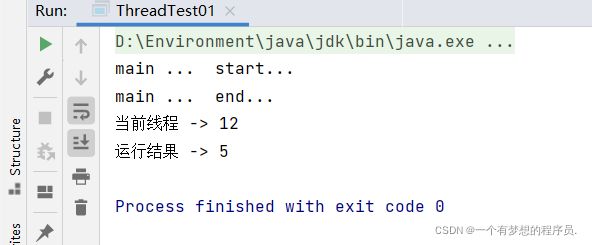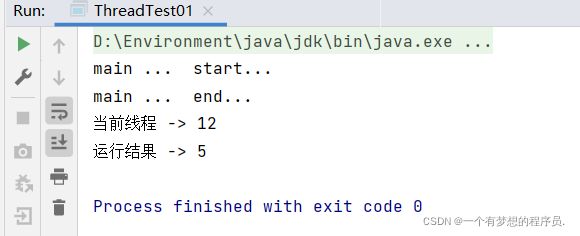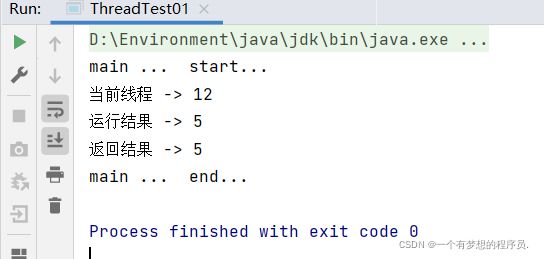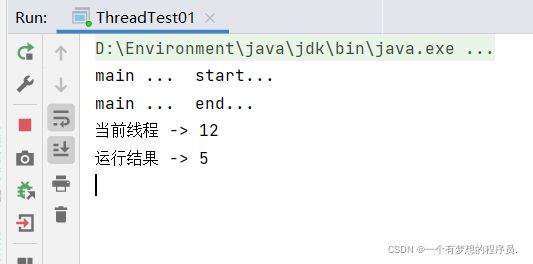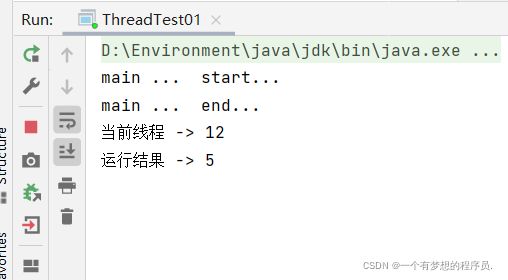线程的几种创建方式
创建线程的4钟方式 * 1.继承Thread类 * 2.实现Runnable 接口 * 3.实现Callable 接口 + futureTask (可以拿到返回结果,可以处理异常) * 4.线程池
1.继承Thread类
public class ThreadTest01 {
//继承Thread类
public static class Thread01 extends Thread{
@Override
public void run() {
System.out.println("当前线程 -> "+Thread.currentThread().getId());
//模拟业务执行
int i = 10/2;
System.out.println("运行结果 -> "+i);
}
}
public static void main(String[] args) {
System.out.println("main ... start...");
Thread01 thread01 = new Thread01();
thread01.start(); //执行异步
System.out.println("main ... end...");
}
}结果
2.实现Runnable 接口
public class ThreadTest01 {
//实现Runnable
public static class Runnable01 implements Runnable{
@Override
public void run() {
System.out.println("当前线程 -> "+Thread.currentThread().getId());
//模拟业务执行
int i = 10/2;
System.out.println("运行结果 -> "+i);
}
}
public static void main(String[] args) {
System.out.println("main ... start...");
Runnable01 runnable01 = new Runnable01();
new Thread(runnable01).start();//开启异步执行
System.out.println("main ... end...");
}
}结果
3.实现Callable 接口 + futureTask
public class ThreadTest01 {
//实现Callable接口
public static class Callable01 implements Callable {
@Override
public Integer call() throws Exception {
System.out.println("当前线程 -> "+Thread.currentThread().getId());
//模拟业务执行
int i = 10/2;
System.out.println("运行结果 -> "+i);
//返回结果
return i;
}
}
public static void main(String[] args) throws ExecutionException, InterruptedException {
System.out.println("main ... start...");
FutureTask task = new FutureTask<>(new Callable01());
new Thread(task).start(); //开启异步执行
//等待线程执行完成 获取返回结果 阻塞等待
Integer o = (Integer) task.get();
System.out.println("返回结果 -> "+o);
System.out.println("main ... end...");
}
} 结果
4.线程池 创建线程池的方式
/**
* 创建线程池的方式
* Executors.newCachedThreadPool(); code是0 所有都可回收
* Executors.newFixedThreadPool(); 固定大小 code = max; 都不可回收
* Executors.newScheduledThreadPool(); 定时任务的线程池
* Executors.newSingleThreadExecutor(); 单线程的线程池,后台从队列获取任务 挨个执行
*/
1.Executors.newFixedThreadPool(10);
/**
* 七大参数
* int corePoolSize, 核心线程数 线程池创建好以后就准备就绪的线程数量 就等待来接收异步任务去执行
* int maximumPoolSize, 最大线程数量 控制资源并发
* long keepAliveTime, 存活时间 如果当前线程大于核心线程数量 释放空闲线程(maximumPoolSize-corePoolSize) 只要线程空闲大于指定的keepAliveTime
* TimeUnit unit, 时间单位
* BlockingQueue workQueue, 阻塞队列 如果任务有很多就会将目前多的任务放在队列里面 只要有线程空闲了 就会从队列里面取出新的任务继续执行
* ThreadFactory threadFactory, 线程的创建工厂
* RejectedExecutionHandler handler 如果队列满了 按照我们指定的拒绝策略拒绝执行任务
*
* 工作顺序
* 1.线程池创建,准备好core数量的核心线程,准备好接受任务
* 2.core满了,就将再进来的任务放入阻塞队列中,空闲的core就会自己去阻塞队列获取任务执行
* 3.阻塞队列满了,就直接开新线程执行,最大只能开到max指定的数量
* 4.max 满了就用RejectedExecutionHandler拒绝任务
* 5.max 都执行完成,又很多空闲。在指定的时间keepAliveTime以后 释放max- core 这些线程
* 6.new linkedBlockingDeque<>():默认是Integer 的最大值 内存不够问题
* 7. 一个线程池 core 7 ; max 20 queue 50 ,100并发进来怎末分配的
* 7个会立即得到执行,50个会进入队列, 再开13个进行执行, 剩下的30个就使用拒绝策略
* 如果不想抛弃 还要执行 callerRunsPolicy
*/
2.ThreadPoolExecutor executor = new ThreadPoolExecutor(5,
200,
10,
TimeUnit.SECONDS,
new LinkedBlockingDeque<>(100000),
Executors.defaultThreadFactory(),
new ThreadPoolExecutor.AbortPolicy()
); 5.线程池 采用Executors 工具类
public class ThreadTest01 {
/**
* 创建线程池 当前系统中 线程池只有一两个 每个异步任务都提交给线程池去执行 控制资源
* Executors.newCachedThreadPool(); code是0 所有都可回收
* Executors.newFixedThreadPool(); 固定大小 code = max; 都不可回收
* Executors.newScheduledThreadPool(); 定时任务的线程池
* Executors.newSingleThreadExecutor(); 单线程的线程池,后台从队列获取任务 挨个执行
*/
public static ExecutorService executorService = Executors.newFixedThreadPool(10);
//实现Runnable接口
public static class Runnable01 implements Runnable{
@Override
public void run() {
System.out.println("当前线程 -> "+Thread.currentThread().getId());
//模拟业务执行
int i = 10/2;
System.out.println("运行结果 -> "+i);
}
}
public static void main(String[] args) throws ExecutionException, InterruptedException {
System.out.println("main ... start...");
//传入一个Runnable
executorService.execute(new Runnable01());
System.out.println("main ... end...");
}
}结果
5.线程池 采用原生
public class ThreadTest01 {
//实现Runnable接口
public static class Runnable01 implements Runnable{
@Override
public void run() {
System.out.println("当前线程 -> "+Thread.currentThread().getId());
//模拟业务执行
int i = 10/2;
System.out.println("运行结果 -> "+i);
}
}
public static void main(String[] args) throws ExecutionException, InterruptedException {
System.out.println("main ... start...");
//传入一个Runnable
ThreadPoolExecutor executor = new ThreadPoolExecutor(5,
200,
10,
TimeUnit.SECONDS,
new LinkedBlockingDeque<>(100000),
Executors.defaultThreadFactory(),
new ThreadPoolExecutor.AbortPolicy()
);
executor.execute(new Runnable01());
System.out.println("main ... end...");
}
}结果
